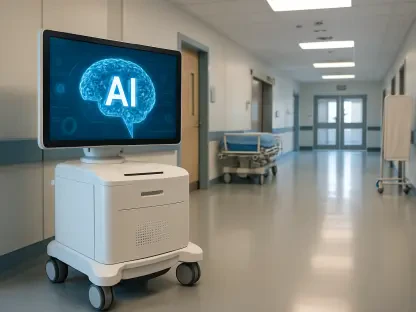Schrödinger, Inc., a company renowned for its computational software in drug discovery, has navigated the biotech landscape for 35 years while traditionally refraining from associating its platform with artificial intelligence (AI). This distinct approach has set Schrödinger apart from pure AI-driven drug discovery firms by emphasizing its physics-based capabilities. However, recent strategic changes indicate that Schrödinger is now embracing AI and machine learning (ML) technologies, marking a significant shift in its operational strategy.
Embracing Change in Drug Discovery
Schrödinger’s journey toward AI integration signals an important evolution in its approach. Historically, the company relied solely on its computational and physics-based software to aid drug discovery, which earned it a strong reputation for reliability and precision. This strategic decision to avoid the AI label allowed Schrödinger to distinguish itself as a powerhouse in physics-based computational methods within the biotech industry. Nevertheless, with advancements in AI and the mounting pressure to stay competitive, Schrödinger has started to weave AI into its fabric, suggesting a readiness to adapt to new trends and technologies.
The CEO’s recent remarks during Schrödinger’s 2024 year-end results highlighted this strategic pivot. The company has committed to incorporating AI and ML into its drug discovery platform, enhancing predictive accuracy and operational efficiency. Encouraged by industry leaders like Jensen Huang, CEO of NVIDIA, Schrödinger has come to acknowledge AI’s untapped potential in refining its software capabilities. This recognition illustrates a proactive stance, marrying the company’s traditional strengths with the innovative edge of AI.
Historical Stance on Artificial Intelligence
For many years, Schrödinger exhibited a cautious approach towards AI, distancing its powerful computational platform from the volatile and often hyped AI sphere. This conservatism meant Schrödinger focused on delivering robust and reliable physics-based software solutions, securing its stature as a trusted partner in drug discovery for leading pharmaceutical companies. By steering clear of AI, the company aimed to build a reputation based on factual accuracy and dependable results from its established methods.
This deliberate stance allowed Schrödinger to carve out a niche, avoiding the speculative ventures that often accompany AI-driven enterprises. The conservative strategy enabled the company to foster a sustainable business model grounded in proven scientific principles. It ensured that Schrödinger’s software was synonymous with precision, reliability, and robust scientific validation, without the speculative volatility of AI promises.
Pivotal Shift Towards AI Integration
Schrödinger’s recent strategic pivot places AI and ML at the heart of its drug discovery endeavors. This change was significantly influenced by Jensen Huang, who encouraged the company to envision a broader scope for AI’s role. The 2024 year-end results underscored Schrödinger’s renewed focus on integrating AI into its platform, aiming to enhance predictive models and streamline the drug discovery process.
CEO Ramy Farid’s comments marked a defining moment, signaling Schrödinger’s commitment to exploring AI’s full potential. This embrace of AI comes at a crucial time when the biotech industry is increasingly dominated by data-driven approaches. The integration of AI is set to augment Schrödinger’s existing computational tools, enhancing their ability to predict molecular interactions and toxicological risks more accurately and efficiently. This strategic shift not only aims to keep Schrödinger competitive but also aligns with industry trends emphasizing the amalgamation of AI with traditional scientific methodologies.
Dual Identity: Software Meets Biotech
Schrödinger’s business model is uniquely positioned at the intersection of software development and biotechnology, presenting both opportunities and challenges in market valuation. As a software firm, Schrödinger licenses its software to major pharmaceutical companies, offering vital tools for drug development. Simultaneously, as a biotech entity, Schrödinger engages in proprietary drug discovery projects, aiming to develop innovative therapies. This dual identity requires proficient handling of two highly competitive sectors, merging the realms of high-tech and high-risk scientific exploration.
The dual approach underscores the company’s ability to address immediate revenue needs through software licensing while investing in long-term, high-reward biotech ventures. Software licensing remains a stable revenue stream, fortified by Schrödinger’s stronghold in the software market. However, proprietary drug development involves navigating unpredictable scientific and regulatory landscapes, highlighting the inherent risks associated with biotech innovation. Balancing these dynamics is crucial for maximizing growth potential and maintaining financial stability.
Intricacies of Schrödinger’s Revenue Dynamics
Schrödinger’s revenue dynamics reflect its dual operational focus. The company’s revenue is predominantly derived from software licensing, which accounted for a significant portion of the 2024 earnings. The shift from on-premise solutions to cloud-based contracts indicates a strategic move towards scalable and flexible software offerings, aligning with broader industry trends. Cloud-based solutions now represent an increasing share of Schrödinger’s software revenue, showcasing its adaptability and modern approach to software distribution.
Despite the stable software income, the drug discovery revenue remains notably volatile. In 2024, this segment saw a substantial decline, underscoring the unpredictable nature of pharmaceutical partnerships and the high-risk, high-reward scenario of biotech investments. Yet, partnerships with pharmaceutical giants like Novartis highlight Schrödinger’s potential for substantial future revenue, contingent upon successful collaborations and therapeutic breakthroughs. The volatility in drug discovery revenues requires Schrödinger to maintain a balanced financial strategy, leveraging steady software income to support ambitious biotech ventures.
Focus on Proprietary Drug Development
A distinct aspect of Schrödinger’s strategy is its substantial investment in proprietary drug development. This focus reflects the company’s long-term vision of pioneering innovative therapeutics. Schrödinger allocates considerable resources to developing its internal drug discovery pipeline, a high-risk and capital-intensive endeavor. The aim is to harness its computational expertise to discover and develop drugs that could revolutionize treatment for various diseases, including cancer.
Despite the potential for groundbreaking discoveries, the path of proprietary drug development is fraught with uncertainties. The outcomes of clinical trials are unpredictable, and failures can significantly impact both financial standing and company reputation. Therefore, Schrödinger’s commitment to this approach demonstrates a willingness to bet on high-reward prospects, coupled with a strategic vision for long-term impact in the pharmaceutical landscape. The balance between investing in proprietary research and maintaining robust software revenue streams is critical for sustaining this ambitious yet risk-laden journey.
AI’s Growing Role in Schrödinger’s Strategy
AI integration is increasingly central to Schrödinger’s strategic direction, enhancing its core software competencies and the drug discovery pipeline. The company’s focus on AI aims to improve predictability and precision, particularly in domains like toxicology. Significant funding from the Bill & Melinda Gates Foundation underscores the importance and potential of AI-enhanced predictive models in addressing critical healthcare challenges.
The AI-driven enhancements are expected to amplify Schrödinger’s software capabilities by refining the accuracy of predictions and reducing the time required for drug discovery processes. This integration serves as a foundation for more efficient and effective development cycles, ensuring that Schrödinger remains at the forefront of innovation in computational drug discovery. Furthermore, these advancements bolster Schrödinger’s competitive edge, providing pharmaceutical clients with superior predictive tools that incorporate cutting-edge AI technologies alongside traditional computational methods.
Adapting to Industry Trends
Schrödinger’s strategic decision to adopt AI and transition towards cloud-based solutions reflects its adaptability to industry trends. The shift from on-premise software to cloud-based services aligns with a broader movement towards flexible, scalable, and cost-effective computing solutions. This transition not only modernizes Schrödinger’s service offerings but also meets the evolving needs of its diverse clientele.
Embracing AI signifies a forward-thinking approach rooted in the understanding that competitiveness in the biotech sector necessitates technological versatility. The integration of AI enhances the predictive power and efficiency of Schrödinger’s platform, ensuring that it remains relevant and valuable in a rapidly evolving market. This adaptability positions Schrödinger as a leader in aligning scientific innovation with technological advancements, setting the stage for sustained growth and industry leadership.
Financial Management and Strategic Agility
Schrödinger’s growth strategy involves managing the volatility inherent in its diverse revenue streams. The steady income from software licensing provides a financial cushion, but the unpredictability of drug discovery revenue necessitates careful financial management. Balancing these revenue dynamics requires strategic agility, ensuring that resources are judiciously allocated to sustain both software innovation and proprietary research initiatives.
Effective financial management is critical as Schrödinger navigates the high-risk biotech sector. The company’s ability to fund its ambitious drug discovery projects through stable software revenue demonstrates strategic foresight. However, this approach necessitates continuous evaluation of investment priorities, ensuring that the long-term goals of transformative drug discovery do not compromise financial stability. Schrödinger’s strategic agility in managing these dual aspects of its business model will be pivotal in achieving sustained growth and stability.
Competitive Position in SaaS and Biotech
Schrödinger’s unique positioning at the crossroads of SaaS and biotech provides competitive advantages, albeit with complex market dynamics. Leveraging software innovation to fund therapeutic discoveries allows Schrödinger to maintain a balanced business model, capitalizing on immediate revenue from software while investing in long-term biotech ventures. This dual strategy requires adept navigation of the competitive landscapes in both sectors, ensuring that Schrödinger remains a leader in innovative drug discovery and a reliable software provider.
The embrace of AI and transition to cloud-based solutions underscore Schrödinger’s adaptability and forward-thinking approach. These strategic decisions position the company to solidify its market stance, offering enhanced software capabilities and pioneering therapeutic solutions. The ability to integrate cutting-edge technologies while managing the inherent risks of drug discovery exemplifies Schrödinger’s commitment to innovation and competitiveness.
Hopes and Challenges for the Future
For 35 years, Schrödinger, Inc. has built a stellar reputation with its advanced computational software, primarily used in drug discovery. Unlike many competitors that quickly integrated artificial intelligence (AI) into their platforms, Schrödinger set itself apart by focusing on its robust, physics-based capabilities. This unique approach allowed the company to carve out a distinctive niche within the biotech landscape.
However, a significant shift in strategy is now underway. Schrödinger is no longer just relying on its traditional methods but is also incorporating AI and machine learning (ML) technologies into its operations. This marks a noteworthy evolution in the company’s approach and indicates a new phase in its development. Embracing AI and ML doesn’t mean Schrödinger will abandon its physics-based roots. Instead, the integration aims to enhance and complement its existing methodologies, offering a more comprehensive and effective drug discovery process.
By combining its well-established physics-based techniques with the cutting-edge advancements offered by AI and ML, Schrödinger aims to increase its efficiency and innovation. This dual approach could potentially accelerate drug discovery timelines, reduce costs, and ultimately lead to better therapeutic outcomes. The strategic pivot demonstrates Schrödinger’s commitment to staying at the forefront of technological advancements in the biotech industry.









